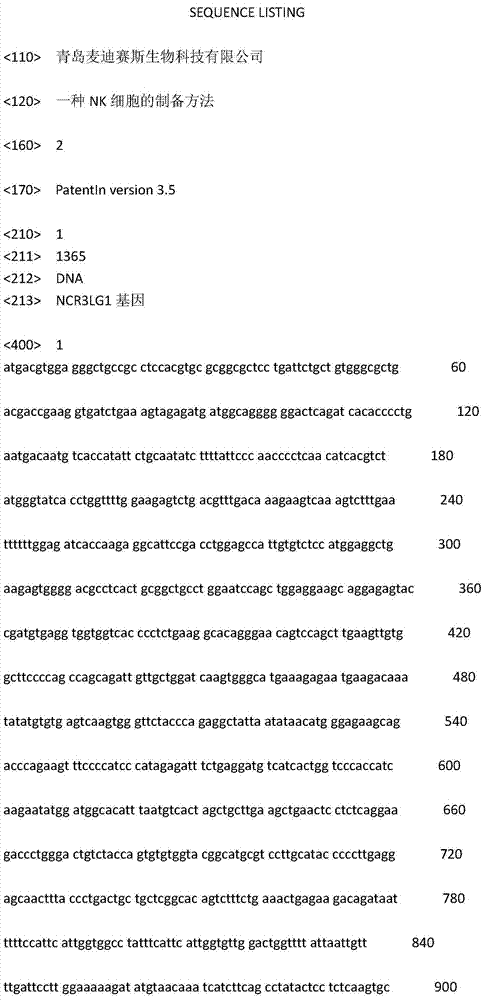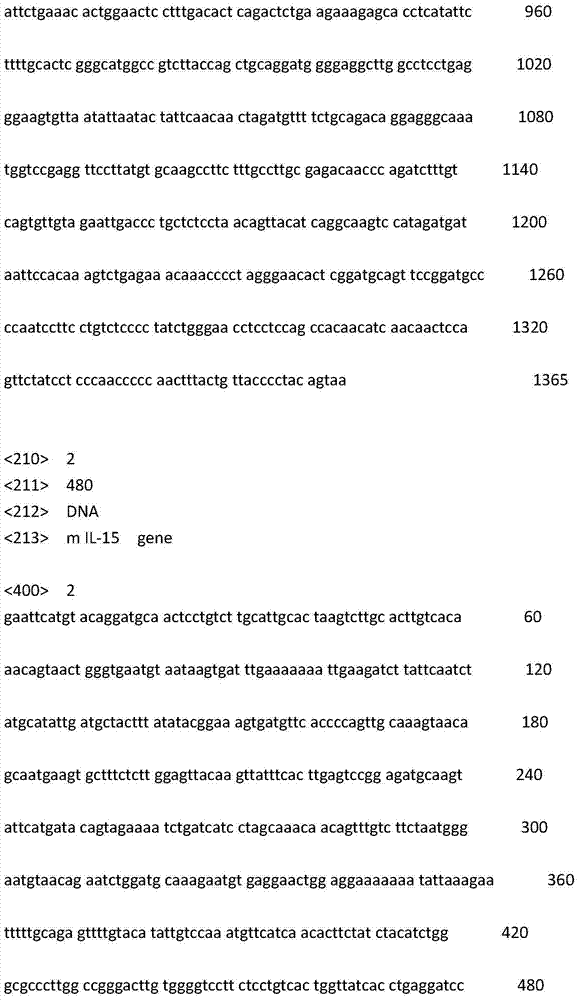Method for preparing NK (natural killer) cell
A technology of NK cells, cells
- Summary
- Abstract
- Description
- Claims
- Application Information
AI Technical Summary
Problems solved by technology
Method used
Image
Examples
preparation example Construction
[0023] The efficient preparation method of NK cells of the present invention comprises the following steps:
[0024] 1) Construction of feeder cells: K562 cells in good condition were selected, and NCR3LG1 and mIL-15 gene nucleotide fragments were respectively inserted into the two multiple cloning sites of the lentiviral vector pEF1alpha-IRES Vector to construct the target gene vector; 24 hours will be 5 x 10 6 A Lenti-X293T packaging cell was inoculated into a 10 cm culture dish; the target gene carrier was mixed with 36 microliters of Lenti-X HTX Packaging Mix, 7.5 microliters of Xfect Polymer, and 1150 microliters of Xfect Reaction Buffer, and allowed to stand at room temperature for 10 minutes. Then add it to the petri dish; place the petri dish in a 37°C carbon dioxide incubator overnight; replace with a new medium; after 48 hours, collect the supernatant and pass it through a 0.45 micron sterile filter, the filtrate contains the target gene virus suspension; the detect...
experiment example 1
[0033] 1) Cell inoculation: collect 50 ml of venous peripheral blood, use lymphocyte separation medium to obtain PBMCs by centrifugation, wash twice with normal saline, resuspend with 60 ml of serum-free medium, sample and count, and the number of cells is 4.6×10 7 . Cells were seeded into culture flasks, and the same number of inactivated feeder cells was added, 360,000 units of IL-2, and 600 ng of IL-21 were added.
[0034] 2) Transfer culture: After inoculated cells were cultured for 4 days, they were transferred to a gas-permeable cell culture bag to continue culturing, adding serum-free medium to 300 ml, adding 15,000 units of IL-2, and 3,000 ng of IL-21.
[0035] 3) Secondary stimulation: when the culture was expanded to the 7th day, samples were counted, and the same amount of inactivated feeder cells were added for secondary stimulation, and IL-2 was added at a concentration of 500 units / ml, and IL‐2 was added at a concentration of 10 ng / ml. Concentrations of IL‐21 we...
experiment example 2
[0040] 1) Cell inoculation: 50 ml of venous peripheral blood was collected, and PBMCs were obtained by centrifugation using lymphocyte separation medium, washed twice with normal saline, and resuspended in 70 ml of serum-free medium. Sampling and counting, the number of cells is 5.1×10 7 . Cells were seeded into culture flasks, and the same number of inactivated feeder cells was added, 420,000 units of IL-2, and 700 ng of IL-21 were added.
[0041] 2) Transfer culture: After inoculated cells were cultured for 4 days, they were transferred to a gas-permeable cell culture bag to continue culturing, adding serum-free medium to 400 ml, adding 20,000 units of IL-2, and 4,000 ng of IL-21.
[0042] 3) Secondary stimulation: when the culture was expanded to the 7th day, samples were counted, and the same amount of inactivated feeder cells were added for secondary stimulation, and IL-2 was added at a concentration of 500 units / ml, and IL‐2 was added at a concentration of 10 ng / ml. Co...
PUM
 Login to View More
Login to View More Abstract
Description
Claims
Application Information
 Login to View More
Login to View More - R&D
- Intellectual Property
- Life Sciences
- Materials
- Tech Scout
- Unparalleled Data Quality
- Higher Quality Content
- 60% Fewer Hallucinations
Browse by: Latest US Patents, China's latest patents, Technical Efficacy Thesaurus, Application Domain, Technology Topic, Popular Technical Reports.
© 2025 PatSnap. All rights reserved.Legal|Privacy policy|Modern Slavery Act Transparency Statement|Sitemap|About US| Contact US: help@patsnap.com


